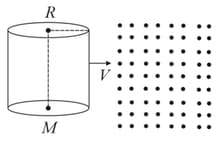Stoke’s Law
Stoke’s Law: Overview
This topic covers concepts such as Stokes Law, Viscous Force on Spherical Bodies, Velocity of Spherical Ball in Viscous Medium, Terminal Velocity of Spherical Ball, Applications of Stokes Law, Velocity of Rain Drops, Descending by a Parachute, etc.
Important Questions on Stoke’s Law
A spherical ball of radius and density falls freely under gravity through a distance before entering a tank of water. If after entering the water the velocity of the ball does not change, find . The viscosity of water is .
A parachute descend slowly because it has a _____ surface area coming down fast.
With the parachute out it adds more friction slowing him down because air resistance works against the very large surface area of the parachute.
Two identical balloons, filled with gases of different densities and are released from an airplane into the atmosphere (density ). Find the speed of lighter balloon as seen by heavier balloon after a long time.
Given: radius of the balloons
Coefficient of viscosity
A raindrop falling in air is similar to motion of what kind of body in viscous medium?
A cylinder of mass and radius moves with constant speed through a region of space that contains dust particles of mass which are at rest. There are number of particles per unit volume. The cylinder moves in a direction perpendicular to its axis. Assume and that the particles do not interact with each other. All the collisions taking place are perfectly elastic and the surface of the cylinder is smooth. The drag force per unit length of the cylinder required to maintain a speed constant for the cylinder when it has entered a region is . Find the value of .

A lead ball of diameter falls through a long column of glycerine. The variation of its velocity with distance covered is represented by
Eight identical drops of water, each of radius are falling through air at a terminal velocity of . If they coalesce to form a single drop, then the terminal velocity of the combined drop will be :
A spherical ball is dropped in a long column of viscous liquid. The acceleration of ball as a function of time may be best represented by the graph:-
Millikan's oil drop experiment is used to find:
Which of the following options is correct regarding the retarding viscous force acting on a spherical ball of radius falling in a viscous liquid with a velocity ?
Best graph from following between terminal velocity of a spherical object and radius of object is
A drop of water of radius is falling in air. If the coefficient of viscosity of air is , the terminal velocity of the drop will be: (The density of water and )
Eight drops of water, each of radius are falling through air at a terminal velocity of . If they coalesce to from a single drop, then the terminal velocity of combined drop will be:
A metallic sphere of mass falls through glycerine, If we drop a ball of mass of same metal into a column of glycerine, the terminal velocity of the ball will be
A spherical ball of radius is falling in a viscous fluid with velocity . The retarding viscous force acting on the spherical ball is:
A copper ball of radius is moving with a uniform velocity in the mustard oil and the dragging force acting on the ball is The dragging force on the copper ball of radius with uniform velocity in the mustard oil is
A rain drop of radius has a terminal velocity in air The viscosity of air is poise. Find the viscous force on the rain drops.
What will be the approximate terminal velocity of a rain drop of diameter , when density of rain water and the coefficient of viscosity of air ?
